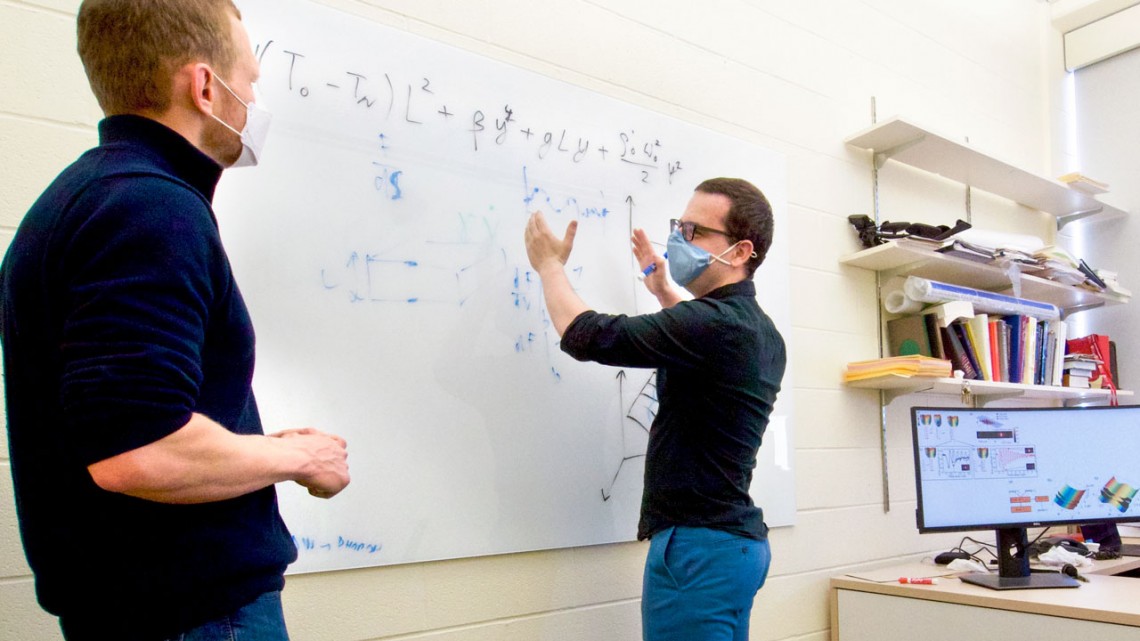
Andrej Singer, left, assistant professor of materials science and engineering, and postdoctoral researcher Oleg Gorobtsov have published a paper on using precisely timed lasers to control changeable properties in a quantum material.
Engineers show new control of phonons using laser pulses
By Chris Dawson
Cornell engineers used precisely timed laser pulses to control changeable properties in a quantum material, pioneering a method that may have wide applications across a class of materials with immense technological interest.
Postdoctoral researcher Oleg Gorobtsov is co-lead author of “Femtosecond Control of Phonon Dynamic Near a Magnetic Order Critical Point,” published May 17 in Nature Communications. Gorobtsov works in the lab of senior author Andrej Singer, assistant professor of materials science and engineering in the College of Engineering.
The engineers used femtosecond laser pulses aimed at specific points in a thin metal film with magnetic order to control the material’s transient phonon state – the vibrational motion in which the material’s atoms oscillate. The technique gives physicists another tool in the quest to control quantum materials at their natural time and length scales, Gorobtsov said.
“Technology is moving into the direction of ever-faster switching between different states of a material,” he said. “Lasers currently offer speeds as fast as one millionth of one billionth (a quadrillionth) of a second. During this switching, detrimental or beneficial non-equilibrium atomic vibrations, or phonons, often arise.”
This method of using multiple photoexcitations to initiate and then either extinguish or control these transitional vibrational states in a material with magnetic order shows qualitatively how phonon dynamics can be controlled using laser pulses.
The work was carried out at the Linac Coherent Light Source at the SLAC National Accelerator Laboratory in Palo Alto, California. Gorobtsov and Singer ran the experiment at the SLAC facility because its X-ray equipment gave them the ability to precisely measure the material’s changes in transitional states.
“Obviously, when these materials are used in real devices, we cannot put a state-of-the-art X-ray source inside to measure the material response,” Gorobtsov said. “However, the unique information from an X-ray free electron laser lets us build a fundamental quantitative model of ultrafast transitions in this material.”
Having this quantitative model will enable researchers to predict the behavior of elemental chromium, the paradigmatic quantum material used in this study, as well as that of many related materials.
This experiment grew out of an earlier study Singer ran, in which he showed that a single laser pulse could initiate a transitional vibrational state in a quantum material.
“We saw that a laser pulse induces an extraordinarily strong response,” Singer said, “and that led us to believe that multiple pulses would offer a unique opportunity to control the magnetic quantum material. Dr. Gorobtsov’s experiment shows that our hypothesis was correct.”
Gorobtsov and Singer see possible applications in the field of spintronics – the study of an electron’s intrinsic spin, its magnetic moment and its charge in solid-state devices. Being able to induce, control and extinguish changes in spin states with precision would have implications in energy harvesting and storage, and in data storage and transfer.
“It is hard to imagine the full range of applications,” Singer said, “but the new fundamental understanding holds promise for new advances in ultrafast science and technology.”
Co-authors include researchers from the Italian Institute of Technology and the University of California, San Diego. The research was supported by the U.S. Department of Energy’s Office of Basic Energy Sciences.
Chris Dawson is a writer for the College of Engineering.
Media Contact
Get Cornell news delivered right to your inbox.
Subscribe
